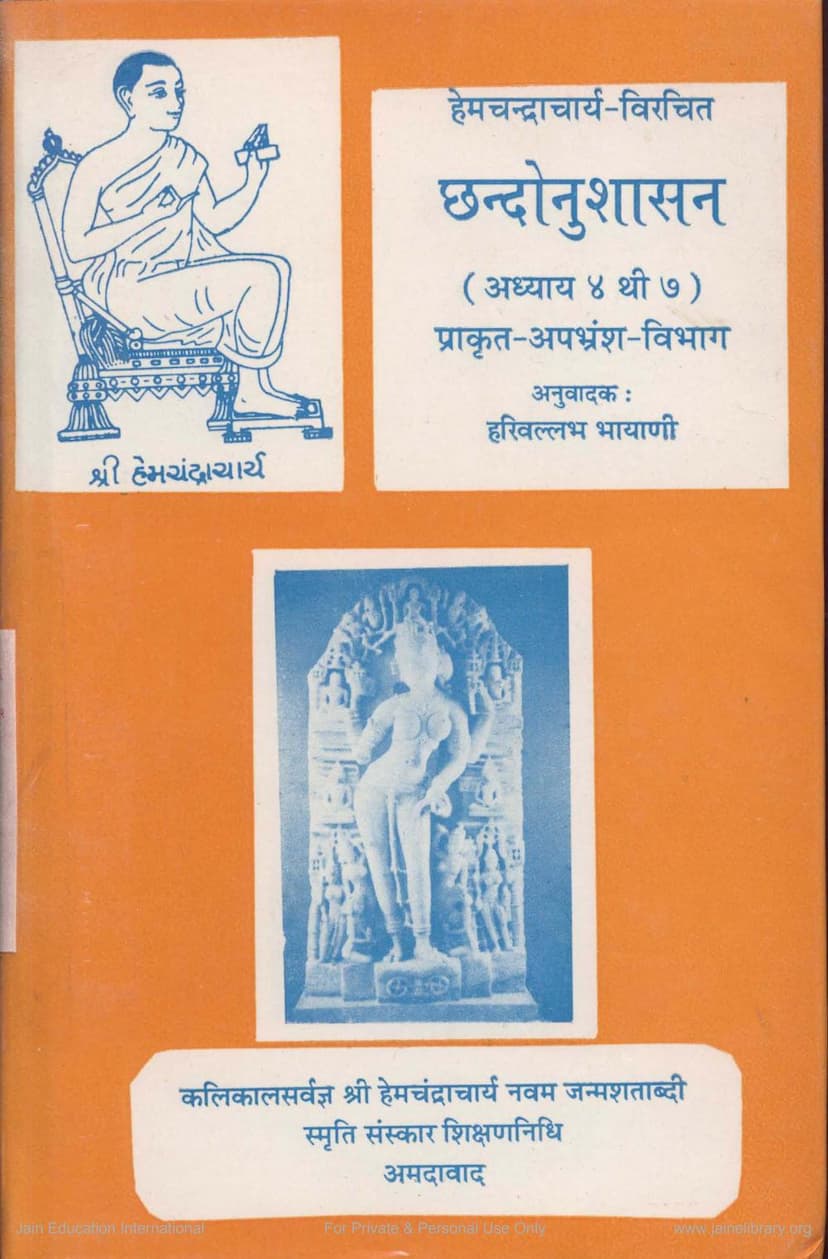Chhandonushasan
Added to library: September 1, 2025

Summary
Here's a comprehensive summary of the Jain text "Chandonushasan" by Hemchandracharya, focusing on the Prakrit and Apabhramsa sections as translated by H. C. Bhayani:
Book Title: Chhandonushasan (Prakrit-Apabhramsa Division) Author: Hemchandracharya Translator: H. C. Bhayani Publisher: Kalikal Sarvagya Shri Hemchandracharya Navam Janmashatabdi Smruti Sanskar Shikshannidhi, Ahmedabad Year of Publication: 1996
Overall Purpose:
This book is a Gujarati translation and analysis of Chapters 4, 5, 6, and 7 of Hemchandracharya's monumental work, "Chhandonushasan." This seminal text is a comprehensive treatise on Sanskrit, Prakrit, and Apabhramsa prosody (the study of poetic meters). The translation by H. C. Bhayani aims to make the complex Prakrit and Apabhramsa sections accessible to Gujarati readers, especially scholars and students of Sanskrit and Prakrit literature.
Key Aspects Covered in the Translated Chapters:
The translated chapters (4 through 7) focus on the prosodical rules and examples for Prakrit and Apabhramsa languages. The summary provided below is based on the table of contents and the introductory sections of the translated work:
-
Chapter 4: Description of Arya, Galitaka, Khanjaka, and Shirsaka (आर्या-गलितक-खञ्जक-शीर्षक-वर्णन)
- Arya (आर्या): This section details the Arya meter, also known as "Gatha" (गाथा) in other languages. It defines its structure, variations (like Pathya, Vipula, Chapala, etc.), and provides examples in Sanskrit and Prakrit. The Arya meter is significant in Prakrit literature.
- Galitaka (गलितक): This covers various forms of the Galitaka meter, characterized by specific patterns of metric units (kalas). Various sub-types like Upagalitaka, Antargalitaka, Vigalitaka, Sangalitaka, etc., are explained with examples.
- Khanjaka (खञ्जक): This section discusses meters belonging to the Khanjaka family. Examples include Khanjaka itself, Mahatonaka, Sumangala, Khanda, Upaskandaka, Khandita, Helā, Āvalī, Vinatā, Vilāsinī, Mañjarī, Śālabhañjikā, Kusumitā, Dvipadī, Rachitā, Ārṇāla, Kāmalekhā, Chandralekhā, and Krīḍanaka.
- Shirsaka (शीर्षक): This part deals with "Shirsaka" meters, which often involve combinations of different meters. Examples include Dvipadī-Khanda, Dvi-bhaṅgikā, Gaṭhā+Bhadrikā, Vastu-nandana, Karpara, Vastu-vadana, Kuṅkuma, Rāsa-valaya, etc.
-
Chapter 5: Description of Utsaha and others (उत्साहादि-वर्णन)
- This chapter focuses on meters related to emotions, festivals, and specific contexts. It covers meters like Utsaha, Rasaka, Avatansaka, Kundda, Karabhaka, Indragopa, Kokila, Dardura, Āmoda, Vidruma, Megha, Vibhrama, Kusuma, Rāsa, Utthaka/Avasthitaka, Dhvala, Mangala, Phulladaka, and Jhaṁbaṭaka.
- It also elaborates on different types of Dhvala meters (Shrīdhavala, Yashodhavala, Kirtidhavala, Gunaḍhavala, Bhramarḍhavala, Amardhavala) and other related meters.
-
Chapter 6: Description of Dhruva, Dhruvaka, Ghattā, Chaturpadī, Shaṭpadī (ध्रुवा-ध्रुवकः-धत्ता-चतुष्पदी-षट्पदी-वर्णन)
- Dhruva/Dhruvaka/Ghattā: This section delves into "Dhruva" meters, which are often used as refrains or concluding verses in narrative poetry (like Sandhi). It explains their types: Shaṭpadī (six-line), Chaturpadī (four-line), and Dvipadī (two-line).
- Shaṭpadī (Six-lined): Detailed classification of Shaṭpadī dhruvas is provided, including Shaṭpada-Jāti, Shaṭpada-Upajāti, and Shaṭpada-Avajāti, each with sub-types.
- Chaturvedī (Four-lined): This covers Chaturpadī dhruvas, also referred to as "Vastuka." It classifies them into Antarasamā, Ardhasamā, Saṅkīrṇā, and Sarvasamā, with numerous sub-categories like Champakakusuma, Sāmudgaka, Malhaṇaka, Rāvaṇahastaka, etc., showcasing complex metrical patterns.
- Raddā (रड्डा): This meter is discussed, often formed by combining different meters with specific rhythmic patterns.
- Mātrā (मात्रा) related meters: This chapter also covers meters based on syllable weight (mātrās), like Mattabalikā, Mattamadhu karī, Mattavilāsinī, and Mattakariṇī, indicating the evolution and variations in metrical composition.
-
Chapter 7: Description of Dvipadī (द्विपदी-वर्णन)
- This chapter focuses on Dvipadī (two-lined) meters, which are prevalent in Apabhramsa poetry. It categorizes them based on their structure and variations, including:
- Karpūra, Kuṅkuma, Laya, Bhramarapad, Upagarudapad, Harinīkula, Gitīsama, Bhramararuta, Harinīpada, Kamalakara, Kuṅkumatilakāvalī, Ratnakaṇṭhikā, Śikhā, Chhaḍḍiṇikā, Skandhakasama, Mauktikadāma, Navakadalīpatra, Skandhaka, Mauktikadāmnī, Navakadālīpatrā, Āyāmaka, Kāñcīadāma, Rasānādāma, Cūḍāmaṇi, Upāyāmaka, Upakāñcīadāma, Uparasānādāma, Upacūḍāmaṇi, Svapnaka, Bhujangavikrānta, Tārādhruvaka, Navaraṅgaka, Sthavirāsana.
- It also details various other Dvipadī forms like Suprabhaga, Pavanaḍhruva, Kumuda, Bhārākrānta, Simh Vikrānta, Kuṅkumakesara, Bālabhujaṅgamalälita, Upagandharva, Saṅgīta, Upagīta, Gondala, Rathayāvarṇaka, Abhinava, Chapala, Amṛta, Simhpad, Dīrghaka, Kaḷakaṇṭhīruta, Atidīrgha, Mattamātaṅgavijūmbhita, and Māladhruvaka.
- The chapter concludes with other Dvipadī forms like Vijaya, Revakā, Gaṇadvipadī, Svaradvipadī, Aparā, Vasudvipadi, Karimkarabhujā, Lávalī, Amarapuravaśundarī, Kāñcanalekhā, Cāru, and Puṣpamālā.
- This chapter focuses on Dvipadī (two-lined) meters, which are prevalent in Apabhramsa poetry. It categorizes them based on their structure and variations, including:
Translator's Contribution (H. C. Bhayani):
H. C. Bhayani's translation is highly valued for its scholarly approach. He draws upon the critical editions of "Chhandonushasan" (like the one edited by H. D. Velankar) and provides a Gujarati rendering that explains the technical terms and complex rules of prosody. The translation includes a preface and notes that shed light on the historical context, the contributions of Hemchandracharya, and the comparative analysis with other prosodists like Svayambhu. Bhayani emphasizes the importance of understanding these meters for appreciating Prakrit and Apabhramsa literature, highlighting the connection between meter, music, dance, and drama in ancient Indian traditions. He also acknowledges the poetic prowess of Hemchandracharya, evidenced in the examples he composed for his work.
Significance of the Work:
- Comprehensive Coverage: Hemchandracharya's "Chhandonushasan" is considered the most exhaustive work on Indian prosody from its time, covering Sanskrit, Prakrit, and Apabhramsa meters systematically.
- Scholarly Foundation: It synthesizes previous knowledge and establishes a standard for the study of poetic meters.
- Literary Value: The examples provided by Hemchandracharya are not just illustrations but often stand as independent lyrical pieces (muktakas), showcasing his poetic talent.
- Accessibility: Bhayani's translation bridges the gap for Gujarati readers to access and understand this vital aspect of Indian classical literature.
- Historical Context: The translation and its accompanying notes offer insights into the evolution of metrical forms and their usage across different linguistic stages of Indian literature.
In essence, this translated work provides a crucial resource for understanding the intricate world of Prakrit and Apabhramsa poetry through the lens of Hemchandracharya's authoritative "Chhandonushasan."